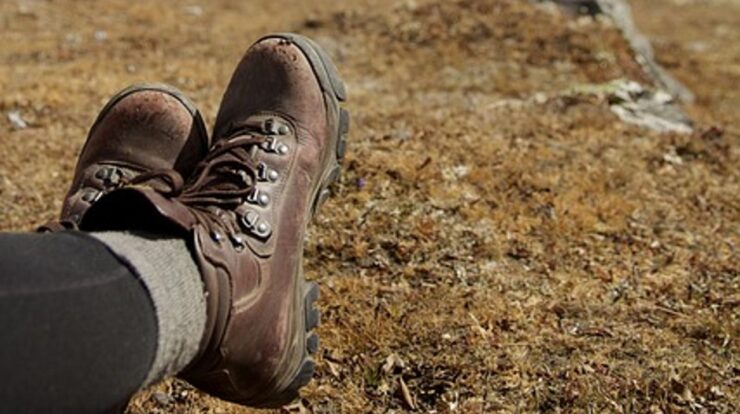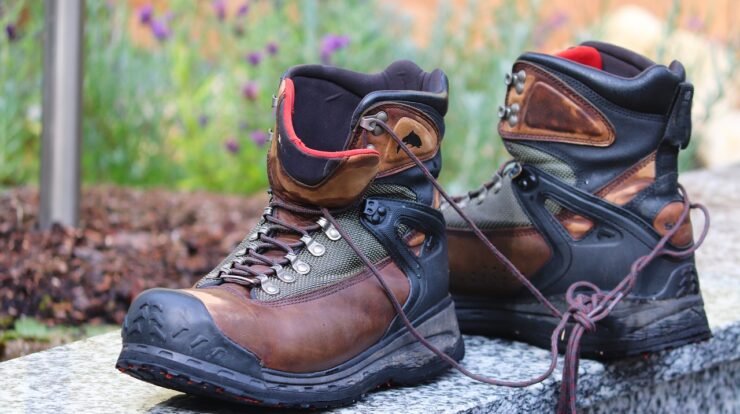
Do you need crutches with a walking boot? This is a question that is often asked. Some think that the answer to this question is obvious because the orthepedic is called a walking boot for a reason and that you can walk with it unaided, that is without crutches.
A walking boot is a medical shoe specifically designed to protect an injured limb from further injuries. It is an orthopedic shoe that helps in the healing of sprains, broken ankle, or tendon injuries and shin splints.
They are sometimes used when you are recovering from foot surgery. Wearing ortho boots help speed up the recovery process by stabilising the injury, but only works if you wear them the right way.
Do You Really Need Crutches with a Walking Boot?
You may walk using a walking boot unaided, that is without crutches if allowed to do so by a medical professional. Their decision is based on the seriousness of your injury and whether or not your injury is classed as weight-bearing, non-weight-bearing or some percentages of weight-bearing in between.
A walking boot provides stability and protection to facilitate healing, and it is never a good idea to wear a walking boot without a good pair of crutches.
In the beginning, your injury may be classed as non-weight-bearing which means that you are not allowed to put any pressure on it. At this point, it is advisable that you use crutches with your walking boots.
As your injury heals your medical professional may allow you to place more of your body weight on the injured leg. This will allow you to regain the full range of motion back in your leg.
Why are Crutches needed?
If your medical professional told you that you are non-weight-bearing or partially weight-bearing you’ll have to use crutches in order to foster proper healing. While being non-weight-bearing you cannot use one crutch or a single cane as a walking aid.
The simple truth is that you have to use two crutches in order to not stunt the healing progress. Always follow your medical professional’s orders, they know what they are doing. If you are using a cane or one crutch, no matter what you say, you are, actually, fully weight bearing on your leg and maybe stunting the proper healing of your injury.
Crutches can be a pain to carry around but if your injury is serious you may use the iwalk2.0 because it allows you to walk handsfree and at the same time put no pressure on your leg. Alternatively, you can use a wheelchair, however, it is more cumbersome and harder to manoeuvre.
How does walking boots help the healing process?
Walking boots are specifically designed to protect the feet after a foot injury or surgery. The boot is used for broken bones, tendon injuries, severe sprains, or shin splints. It helps to immobilize the bone and tendons and keeps the foot stable so it can head and prevent reinjury.
Walking normally produces a shock impact with each step and may cause re-injury that is why the walking boots were invented. Therefore, keeping your weight off your foot would be a great help, such as your toe, as it heals.
The walking boot protects your leg injury one step at a time. Here are some of the main benefits of a walking boot:
- Made from tough plastics to keep the foot stable and prevents movement in the affected area.
- Designed with shock absorbers to reduce the impact of walking on the weakened bone and tendons.
- Helps the foot to breathe after surgery while still protecting the injury.
Walking in a walking boot with crutches? Precautions
When walking in a walking boot you have to take a number of precautions to ensure that your foot heals properly.
1. You Must Wear the Right Size and Perfect Fit
Wear a walking book that is the perfect fit for you. It should be at least half-inch extra at the top of the boot next to the big toe.
2. Balance the walking boot with Your other Foot
The walking boot will increase your height by an inch and cause balancing problems, therefore, it is good to adjust your other foot by wearing a height adjuster. If your gait is uneven it will cause knee, hip and back pain.
3. Use both crutches
Throughout your healing process use your crutches properly. Use both crutches if your leg is not fully healed. If it is just a sprain you may be able to gait without a crutch.
Weight bearing or partially weight bearing when using a crutch
If your doctor told you that you are none weight bearing or partially weight bearing then you have got to use crutches in order to foster proper healing. While being non-weight-bearing you must use a crutch or some other device to prevent pressure from being placed on the foot.
You cannot use one crutch or a single cane as a walking aid. The simple truth is that you have to use two crutches in order to follow doctor’s orders and not stunt your healing progress. If you’re not using two crutches instead of just using a cane or one crutch, no matter what you say, you are actually fully weight bearing on your leg and may be stunting the proper healing process.
Don’t be like the patients that go against the doctors’ orders and make their leg fully weight-bearing unknowingly by using one crutch and then lying about it.
Walking boot discomfort: Walking with crutches or without crutches
Breaking a bone in your leg or foot can put you out of commission for weeks. Getting back on your feet is important and learning to walk with a walking boot and crutches is the first step to getting you up and moving.
The hardest part of using a walking boot and crutches is the initial pain from putting weight on your broken bone. As your broken bone heals and you practice walking more, the pain will become manageable before dissipating altogether.
How to walk in a walking boot with crutches when you are partially weight-bearing.
Wear your walking boot as directed by your doctor. Move your foot in a normal walking motion without putting weight on it at first while using crutches to support your full weight.
You want to get used to the weight of the walking boot and moving your foot in a normal walking motion again.
Put slight weight on the injured leg on which you are wearing your walking boot and use your crutches to support the rest of your weight.
You can either apply weight at the heel or toe of the boot, depending on which results in less painful.
Continue walking around like this until the pain begins to dissipate. But avoid developing a habit of using part of your foot and not the rest.
Begin putting your full weight on the walking boot and only use the crutches as a backup to keep your balance. This will be slightly painful but after a few days, the pain should dissipate. Do not quit using your crutches before a doctor has given you permission.
How to walk in a walking boot with crutches when you are none weight bearing
You can stand on the none injured foot with the crutches – one under each arm. The next step is to put the crutches one step forward then swing your body ahead using the crutches to balance. You should always try to land on the good leg because the other is none weight-bearing.
How to walk in a walking boot without crutches when you are fully weight-bearing
When you are fully weight-bearing you can walk on your foot as normal. But remember not to put too much pressure on your foot. While walking you may feel some pain but you can still walk as long as the pain is bearable.
The Conclusion to the questions ‘Do you need crutches with a walking boot.
Crutches may be given to individuals with sprains or fractures of the leg and crutches may be given depending on the seriousness of the injury. In many cases, the walking boot would be the best option.
If you are looking to purchase standard crutches I recommend looking on secondary sites like eBay, craigslist or checking out thrift shops on the high street.
If you will be needing to use crutches for a while I recommend you get a quality pair of crutches or look into some of the new Crutch alternatives like the iwalk 2.0 or the knee scooter. Both of these options are great choices that others swear by and are both available on Amazon.
Warnings
Do not quit using your walking boot or crutches without a doctor’s permission.
Do you need crutches with a walking boot: Tips to relieve walking boot discomfort
Be sure to prop your broken leg up whenever possible since applying weight and using your leg will increase swelling. Also, the resultant decrease in blood flow to a body part elevated higher than your pumping heart will have an effect in pain subsiding.
When you feel you are well enough to walk with one crutch, it should actually be used with your uninjured foot so that most of the walking pressure is applied to that stride and not the one where your recovering foot is standing on its own.
The information provided on Boot walker is for informational purposes only. Always seek advice from a medical professional.






